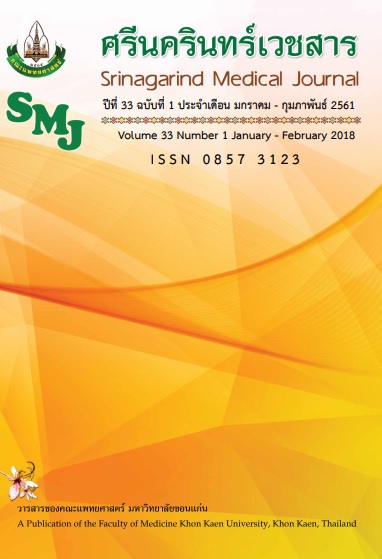A Comparison Study between the Effects of Thai Herbal Steam and Conventional Steam on Pain Scale, Back and Leg Flexibility in Person with Low Back Pain
Keywords:
Herbal Steam; Low Back Pain; Pain; Flexibility; อบไอน้ำ; ปวดหลังส่วนล่าง; ระดับความเจ็บปวดAbstract
Background and Objective: Thai herbal steam may use as an alternative treatment for decreasing back pain. The purpose of this study was to compare the effect of Thai herbal and conventional steam on pain scale, flexibility of back and leg in person with low back pain.
Methods: Thirty five participants with non-specific low back pain aged between 35 to 60 years, were divided into two groups. 19 participants were received with Thai Herbal Steam and 16 participants were received conventional steam. Each group was received steam for 3 times and was evaluated pain by visual analog scale (VAS) and flexibility of back and leg muscles by sit and reach test before and the end of steam.
Results: After the program both groups were decrease significantly of pain and increase significantly of back and leg flexibility (p<0.05). When compared between groups, Thai herbal steam group (-36.68±13.72 mm.) was decrease significantly of pain than the conventional steam group (-19.94±11.46 mm.) p<0.001 and increase significantly of flexibility of back and leg muscles (7.11±4.25 cm.) greater than the conventional steam group (3.47±2.39 cm.) p=0.007.
Conclusion: Thai herbal steam can decrease pain and increase flexibility of back and leg muscles. Pain decreasing may be the effect from heat, properties and aroma of herbs.
การศึกษาเปรียบเทียบผลระหว่างการอบไอน้ำสมุนไพรไทยและการอบไอน้ำธรรมดาต่อระดับความเจ็บปวดและความยืดหยุ่นของกล้ามเนื้อหลังและขาในผู้ที่มีอาการปวดหลังส่วนล่าง
ศิรินทิพย์ คำฟู *, อรรจน์มน ธรรมไชย, ณิชาภา พาราศิลป์, พุทธิพงษ์ พลคำฮัก, อรุณรัตน์ ศรีทะวงษ์, วีระศักดิ์ ต๊ะปัญญา, เกวลี สีหราช, ปาจรีย์ มาน้อย
สาขาวิชากายภาพบำบัด คณะสหเวชศาสตร์ มหาวิทยาลัยพะเยา
หลักการและวัตถุประสงค์: การอบไอน้ำสมุนไพรอาจเป็นทางเลือกหนึ่งในการช่วยลดอาการปวดหลัง วัตถุประสงค์ของการศึกษานี้ เพื่อเปรียบเทียบผลระหว่างการอบไอน้ำสมุนไพรไทยและการอบไอน้ำธรรมดาต่อระดับความเจ็บปวดและความยืดหยุ่นของกล้ามเนื้อหลังและขาในผู้ที่มีอาการปวดหลังส่วนล่าง
วิธีการศึกษา: ศึกษาในผู้ที่มีอาการปวดหลังส่วนล่าง อายุ 35-60 ปี จำนวน 35 ราย แบ่งเป็น กลุ่มอบไอน้ำสมุนไพรไทย จำนวน 19 ราย และกลุ่มอบไอน้ำธรรมดา จำนวน 16 ราย อบไอน้ำจำนวน 3 ครั้ง ประเมินระดับความเจ็บปวดโดย Visual analog scale ความยืดหยุ่นของกล้ามเนื้อหลังและขาด้วย Sit and reach test ก่อนและหลังการอบไอน้ำ
ผลการศึกษา: เมื่อเปรียบเทียบก่อนและหลังอบไอน้ำ ทั้งสองกลุ่มมีระดับความเจ็บปวดลดลงและความยืดหยุ่นของกล้ามเนื้อเพิ่มขึ้นอย่างมีนัยสำคัญทางสถิติ (p<0.05) และเมื่อเปรียบเทียบระหว่างกลุ่มพบว่ากลุ่มอบไอน้ำสมุนไพรไทย มีระดับความเจ็บปวด (-36.68 ±1 3.72 มม.) ลดลงมากกว่ากลุ่มอบไอน้ำธรรมดา (-19.94 ± 11.46มม.) (p<0.001) และความยืดหยุ่นของกล้ามเนื้อ (7.11 ± 4.25 ซม.) เพิ่มขึ้นมากกว่ากลุ่มที่ได้รับการอบไอน้ำธรรมดา (3.47 ± 2.39 ซม.) อย่างมีนัยสำคัญทางสถิติ (p=0.007)
สรุป: การอบไอน้ำสมุนไพรไทยสามารถลดระดับความเจ็บปวดและเพิ่มความยืดหยุ่นของกล้ามเนื้อหลังและขาได้ ซึ่งอาการปวดที่ลดลงอาจเนื่องมาจากผลของความร้อน สรรพคุณและกลิ่นของสมุนไพร




